Wednesday, February 10, 2010
Report on the situation of human rights and fundamental freedoms of indigenous peoples in Kenya
I am quoting part of the text and offer a link to the full document at the bottom of this post.
...
C. Hunter-gatherers and forest peoples
36. Settlement schemes, logging and charcoal production have put a severe strain on Kenya’s rich and varied forests, and have resulted in the loss of the traditional habitat of Kenya’s forest peoples, the indigenous hunter-gatherers such as the Awer (Boni), Ogiek, Sengwer, Watta, and Yaaku. While existing laws are oriented to the protection of wildlife and forest resources, many of these communities can no longer live by their traditional livelihoods, and their cultures and language are rapidly vanishing as a result; illegal logging has played a major role in this as well.
37. The way of life of the Ogiek is well adapted to the Mau Forest environment where they have lived for centuries. Numbering about 20,000 countrywide, they have been dispersed and assimilated in recent decades, and dispossessed of their traditional source of livelihood. When the Mau Forest was gazetted as a National Forest in 1974, the Ogiek were evicted from their traditional habitat without prior consultation or compensation, in violation of their basic human rights. They were henceforth prevented from hunting or collecting bee honey for survival in the forest, and were reduced to a miserable subsistence on the margins of this area rich in plants and wildlife. On the other hand, illegal logging, the introduction of exotic plantations and the excision of parts of the forest for private development by outside settlers have endangered the Mau Forest as a water catchment area, as well as the country’s environmental security. The Special Rapporteur on adequate housing, Miloon Kothari, signalled in his report on his mission to Kenya that the destruction of the forest has affected the rights of the Ogiek to housing, health, food and a safe environment, threatening to further destroy their cultural identity and the community as a whole (see E/CN.4/2005/48/Add.2, para. 61).
38. Despite a court injunction in their favour in 1997, the Government has proceeded to alienate Ogiek forest land, and a recent court decision does not recognize the Ogiek’s ancestral title to the forest. Still, the Government has distributed title deeds to land to several thousand Ogiek, and some non-Ogiek outsiders have tried to enrol as Ogieks in the hope that they may eventually also be given title deeds. The unresolved conflict between the Ogiek and their neighbours continues to this day. Being considered as squatters on their own land and legally banned from using the forest resources for their livelihood, their attempt to survive according to their traditional lifestyle and culture has often been criminalized and their repeated recourse to the courts has not been successful. Ogiek attribute this vulnerability to the fact that they are not recognized as a distinct tribe and therefore lack political representation. The Special Rapporteur met with members of several Ogiek villages, listened to their grievances and heard their demands for the recognition of their right to land and to maintain their traditional lifestyle in the forest.
...
90. In view of the above, the Special Rapporteur makes the following recommendations:
A. Recommendations to the Government
...
Forest areas
102. The rights of indigenous hunter-gatherer communities (particularly the Ogiek in Mau Forest) to occupy and use the resources in gazetted forest areas should be legally recognized and respected. Further excisions of gazetted forest areas and evictions of hunter-gatherers should be stopped. Titles derived from illegal excision or allocation of forest lands should be revoked, and new titles should only be granted to original inhabitants. Illegal commercial logging should be stopped.
C. Recommendations to indigenous communities and organizations
...
124. Indigenous peoples’ organizations are encouraged to develop concrete strategies for data collection, research and documentation to support their advocacy work both at the national and international levels.
D. Recommendations to civil society and political parties
...
127. NGOs and donors should strengthen their relations with indigenous communities, support their development initiatives and promote a better understanding of their demands and aspirations within Kenyan society.
...
Read / download the full document.
Monday, February 08, 2010
Knowledge and cultural transmission in Kenyan participatory mapping
In this 5 minute interview Dr. Nigel Crawhall, Director of Secretariat at IPACC, elaborates on intergenerational ecological knowledge transmission in Participatory 3-dimensional modelling (P3DM). Crawhall discusses his observations on intergenerational interaction when the Ogiek community of Nessuit, Kenya built a geo-referenced model of their mountain forest landscape in 2006.
Sunday, February 07, 2010
Geographic Information Science and Public Participation
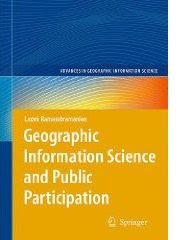 Computer-mediated participation is at the crossroads. In the early heady days of the digital revolution, access to "high" technologies such as GIS promised the empowerment of marginalized communities by providing data and information that was previously hidden away from public view. To a great extent, this goal has been achieved at least in the U.S. and Western Europe – data about a range of government initiatives and raw data about different aspects of spatial planning such as land use, community facilities, property ownership are available a mouse-click away. Now, that the public, have access to information, are we able to make better plans for the future of our cities and regions? Are we more inclusive in our planning efforts? Are we able to foster collaborative governance structures mediated by digital technologies?
Computer-mediated participation is at the crossroads. In the early heady days of the digital revolution, access to "high" technologies such as GIS promised the empowerment of marginalized communities by providing data and information that was previously hidden away from public view. To a great extent, this goal has been achieved at least in the U.S. and Western Europe – data about a range of government initiatives and raw data about different aspects of spatial planning such as land use, community facilities, property ownership are available a mouse-click away. Now, that the public, have access to information, are we able to make better plans for the future of our cities and regions? Are we more inclusive in our planning efforts? Are we able to foster collaborative governance structures mediated by digital technologies?In Geographic Information Science and Public Participation (Advances in Geographic Information Science)
The foreword for the book is written by Prof. Bill Huxhold.
Tuesday, February 02, 2010
Digital Cartography
Digital Cartography from dynamicmediainstitute.org on Vimeo.
By Andrew Ellis, Alexander Wang, Students at the Dynamic Media Institute, Massachusetts College of Art and Design
Digital Cartography is a short documentary film on the transition of maps into their digital form. In this film we speak with programmer and mapmaker Jeffrey Warren from the MIT Media Lab and Dietmar Offenhuber from SENSEable City Lab at MIT. We explore the cultural, economic and technical aspects of mapmaking and how they affect the way we communicate with one another.
In our interviews with Jeffrey and Dietmar we learn about the social and geographical ramifications of building maps and how designers can implement their literacy in communication design to explore different avenues for mapping. Participatory mapping such as Open Street Maps and psychogeography and the virtual dérive are some of the themes discussed around the history and future of mapping in the digital age. Jeffrey gives us a demonstration on low cost arial photography using a helium balloon and a consumer digital camera to stitch photos onto google maps.
Metodología participativa para construir una maqueta 3D en Telpaneca, Nicaragua
El video es una producción de la Unión Nacional de Agricultores y Ganaderos (UNAG) de Nueva Segovia, y la ONG francesa Agrónomos y Veterinarios Sin Fronteras (AVSF).
Monday, February 01, 2010
Community Mapping in Tsunami Affected Areas in Aceh, Indonesia
The documentary has been jointly produced by the Indonesia Community Mapping Network or Jaringan Kerja Pemetaan Partisipatif (JKPP), and the Center for people Economic Development or Yayasan Rumpun Bambu Indonesia (YRBI).
More videos on participatory mapping are found here.
Sunday, January 31, 2010
CyberTracker releases a sample database for Disaster Relief Rapid Surveying
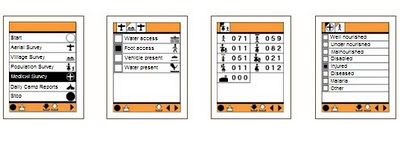 The CyberTracker software can be installed on GPS-enabled Windows Mobile smartphones.
The CyberTracker software can be installed on GPS-enabled Windows Mobile smartphones.This may help to gather crucial data required to co-ordinate disaster relief logistics.
One of the critical problems in disaster relief management is the lack of reliable data on basic needs on the ground after a major natural disaster. Disaster relief efforts must overcome serious logistical problems due to poor communication and unreliable information. Gathering good quality data on the ground will make it possible to make informed decisions on where the highest priorities are.
Better information on quantities of relief supplies needed, such as medicines, food, blankets, shelter and clothing will ensure that resources are used more efficiently where they are needed most.
Source: Louis Liebenberg, CyberTracker Conservation
Saturday, January 30, 2010
Indigenous People’s Exchanges Amongst Philippines and Peru Promoted by CBCD and ALDAW
 The establishment of this linkage took place right at the time when indigenous peoples of the Amazonian Peru had began various forms of open resistance against hydrocarbon extraction in their traditional territories. The solidarity link between the IPs of Peru and Palawan is being consolidated through the collaboration of the Ancestral Land/Domain Watch (ALDAW), the Peoples and Plants International (PPI) and, specifically, through the personal efforts of Dr. Miguel Alexiades (CBCD staff and PPI co-director). Such exchange promotes the sharing of experiences as a way of 1) fostering reflection and joint actions through the establishment of strategic alliances; and 2) addressing common problems regarding indigenous links, rights and claims over ancestral homelands and cultural landscapes.
The establishment of this linkage took place right at the time when indigenous peoples of the Amazonian Peru had began various forms of open resistance against hydrocarbon extraction in their traditional territories. The solidarity link between the IPs of Peru and Palawan is being consolidated through the collaboration of the Ancestral Land/Domain Watch (ALDAW), the Peoples and Plants International (PPI) and, specifically, through the personal efforts of Dr. Miguel Alexiades (CBCD staff and PPI co-director). Such exchange promotes the sharing of experiences as a way of 1) fostering reflection and joint actions through the establishment of strategic alliances; and 2) addressing common problems regarding indigenous links, rights and claims over ancestral homelands and cultural landscapes. The envisaged goal is to enable the production of jointly produced video materials that could be used to exert pressure at a national and international policy level.
The envisaged goal is to enable the production of jointly produced video materials that could be used to exert pressure at a national and international policy level.Julio Cusurichi, representing the indigenous organization COINBAMAD (Consejo Indigena de la Cuenca Baja de Madre De Dios) and winner of the well-known award, the Goldman Prize - arrived in the Philippines on July 2009, leaving the country after 21 days. He traveled to Palawan (Philippines) accompanied by Dr. Novellino and the ALDAW (Ancestral Domain/Land Watch) staff. In Palawan, local indigenous organizations (Bangsa Palawan Philippines and NATRIPAL) facilitated the dialogue between Julio and different Palawan communities, while Dr. Novellino helped in the simultaneous translation from Spanish to Palawan language. During his stay, Julio met many indigenous leaders and communities’ members (including women and children) and shared his experience and lessons regarding the impacts of mining and other forms of commercial extractivism upon cultural landscapes and ancestral homelands. Participatory videos showing the impact of mining and oil extraction in Madre de Dios (Peru) have been shown also to the most isolated Palawan communities.
Through Julio’s visit, a process of direct exchange between grassroots indigenous mobilization in Madre de Dios, Peru and local indigenous anti-mining movements in Palawan has been initiated. Before Julio’s departure, this collaboration has been formalized in a Memorandum of Understanding. Video shootings made by Julio Cusurichi in Palawan have been taken back to Peru and will be shown to the Amazonian indigenous communities. A cross-visit of Palawan representatives to the Peruvian Amazon has been planned for the year 2010.
Saturday, January 23, 2010
Counter-mapping in the Philippines: The Gantong Geo-Tagged Report
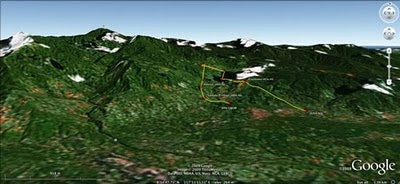 The mission’s actual ‘matching’ of collected GPS data to photographs shows that the Mineral Production Sharing Agreements (MPSA) of two mining firms [MacroAsia and Celestial Nickel Mining and Exploration Corporation (CNMEC) now operated by Ipilan Nickel Corporation (INC)] overlap with precious watersheds endowed with numerous creeks, springs and waterfalls providing potable water to the local indigenous communities and lowland farmers. More importantly, under the ECAN Guidelines of the Strategic Environmental Plan for Palawan (Republic Act 7611), such areas constitute the so called “core zones” of maximum protection where industrial extractive activities are not allowed.
The mission’s actual ‘matching’ of collected GPS data to photographs shows that the Mineral Production Sharing Agreements (MPSA) of two mining firms [MacroAsia and Celestial Nickel Mining and Exploration Corporation (CNMEC) now operated by Ipilan Nickel Corporation (INC)] overlap with precious watersheds endowed with numerous creeks, springs and waterfalls providing potable water to the local indigenous communities and lowland farmers. More importantly, under the ECAN Guidelines of the Strategic Environmental Plan for Palawan (Republic Act 7611), such areas constitute the so called “core zones” of maximum protection where industrial extractive activities are not allowed.At an altitude of about 500m ASL the mission reached indigenous settlements inhabited by very traditional Palawan having limited contacts with the outside. Their sustenance totally depends on the available forest resources, and it consists of a heterogeneous economy where sustainable swidden cultivation is integrated with foraging and the collection of non-timber forest products (NTFPs).
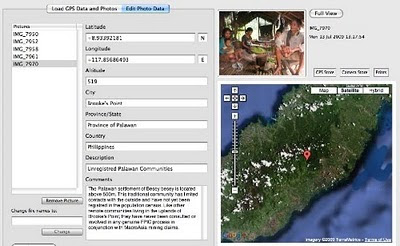
Overall, the mission moved from an elevation of a few meters ASL to an altitude of about 670m ASL, where one of the furthermost Palawan settlements is located. The mission’s GPS coordinates were obtained through the use of the JOBO GPS device being connected to the camera’s hot shoe. Positions were taken at intervals of several meters in order to reconstruct the mission’s full itinerary. The geo-tagged images were then loaded into ‘Photo GPS Editor’ and displayed on satellite Google map. All upland Palawan interviewed during the ALDAW/CBCD mission have declared that they have never been consulted about the entrance of mining companies in their traditional territories.
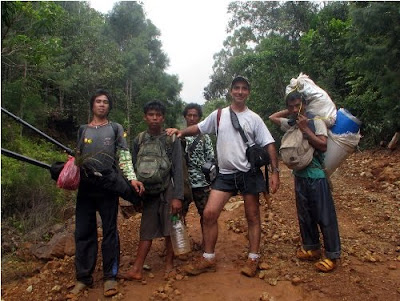
According to indigenous representatives, the Palawan branch of the National Commission on Indigenous Peoples (NCIP) – the government body mandated to ‘protect and promote the interest and well-being of cultural communities’ – is now siding with the mining companies. It is hoped that the ALDAW/CBCD Gantong geo-tagged report will facilitate the circulation of information, at both the national and international levels, on the threats faced by ‘irresponsible mining’ in the Philippines’ “last frontier”. An international campaign to support indigenous Palawan claims to their ancestral land has also been initiated by Survival International.
Source: The ALDAW NETWORK
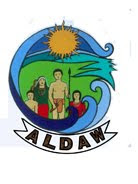
The ALDAW NETWORK (Ancestral Land/Domain Watch) is an advocacy-campaign network of Indigenous Peoples jointly constituted by NATRIPAL (United Tribes of Palawan) and BANGSA PALAWAN PHILIPPINES (Indigenous Alliance for Equity and Wellbeing) on August 2009.
Friday, January 22, 2010
Peter Poole traces the evolution of participatory map-making
In this interview, Dr. Peter Poole traces the evolution of a participatory map-making which commenced with the introduction of GPS to the Inuits in 1989 and evolved throughout the 1990s via a series of projects in the Amazon, the Arctic and Asia.
Tenure maps depict indigenous names, resources and special places on scaled maps, intended as evidence in negotiating processes. Peter describes the search for cheap, simple, appropriate geomatic technology. Community-based teams would gather raw field data and indigenous associations or support NGOs, set up mapping units to serve the field teams.
Three lessons are described: (i) communities can make their own scaled maps, (ii) emerging mapping centres should make their services accessible to all communities, (iii) this methodology not only produces a tenure map, but also equips and inspires community mappers to diversify their skills in environmental information management.
Thursday, January 21, 2010
The Bulanjao Geotagged Report
Geo-referenced audio-visual and photographic documentation was carried out in the Bulanjao range whose vegetation consists of a very unique type of forest growing on ultramafic /heavy-metal rich soils. The area is home to at least four plant species that are classified as vulnerable and two of them have already been included in the IUCN Red List.
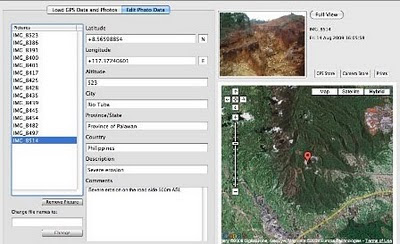 In spite of its unique ecological features, the Bulanjao range has been subjected to mineral exploration and development by the Rio Tuba Nickel Mining Corporation (RTNMC). RTNMC is a Filipino-Japanese partnership holding a mining concession area of about 5,265 hectares.
In spite of its unique ecological features, the Bulanjao range has been subjected to mineral exploration and development by the Rio Tuba Nickel Mining Corporation (RTNMC). RTNMC is a Filipino-Japanese partnership holding a mining concession area of about 5,265 hectares.RTNMC and its partner, Coral Bay Nickel Corporation (CBNC), need to mine nickel ores as part of the expansion of their new Hydrometallurgical Processing Plant (HPP) project. However, one the conditions specified in the Environmental Compliance Certificate (ECC) issued to them in 2002, is that “core zones” - as identified by the Strategic Environmental Plan for Palawan (Republic Act Republic Act 7611) should not be included in the areas of mining operations and, this, of course includes the Bulanjao range.
 Starting at an elevation of about 40m ASL, the ALDAW/CBCD mission followed the mining road to reach the highest portions of the Bulanjao range. Geo-tagging evidence indicates that erosion on the Bulanjao mining road is occurring also at low elevations. During the rainy season the water creates deep clefts on the roadsides, hence penetrating the soil and fostering road collapse. No mitigating measures have been put into place to reduce erosion. A huge crater-like excavation has been found at 566m ASL. and land slides, induced by road construction, have been documented around the sources of the Sumbiling river, at almost 900m ASL. The latter is the most important water source for both lowland farmers and indigenous communities.
Starting at an elevation of about 40m ASL, the ALDAW/CBCD mission followed the mining road to reach the highest portions of the Bulanjao range. Geo-tagging evidence indicates that erosion on the Bulanjao mining road is occurring also at low elevations. During the rainy season the water creates deep clefts on the roadsides, hence penetrating the soil and fostering road collapse. No mitigating measures have been put into place to reduce erosion. A huge crater-like excavation has been found at 566m ASL. and land slides, induced by road construction, have been documented around the sources of the Sumbiling river, at almost 900m ASL. The latter is the most important water source for both lowland farmers and indigenous communities.Marylin Samparan, a local IP living in the area told the mission: “time will come when our children will no longer recognize the names of trees, the footprints of animals, the birds’ songs. This will be the time when the forest will be gone, the mining companies will be gone, the rivers will no longer flow…and us? We will still be here”.
On 15 August 2009, the mission established that mining road had already reached an altitude of 859m ASL – and its exact location was defined through the following GPS coordinates (+ 8.59322548 N Latitude and + 117.36516571 E Longitude).
 Mission’s findings have now been compiled into a geo-tagged report, which is being used by local indigenous communities to support their legal struggle against mining in Bulanjao.
Mission’s findings have now been compiled into a geo-tagged report, which is being used by local indigenous communities to support their legal struggle against mining in Bulanjao.Source: The ALDAW NETWORK
The ALDAW NETWORK (Ancestral Land/Domain Watch) is an advocacy-campaign network of Indigenous Peoples jointly constituted by NATRIPAL (United Tribes of Palawan) and BANGSA PALAWAN PHILIPPINES (Indigenous Alliance for Equity and Wellbeing) on August 2009.
Tuesday, January 19, 2010
What 3-D mapmakers should know about expanded EVA / PE closed-cell foam or sponge
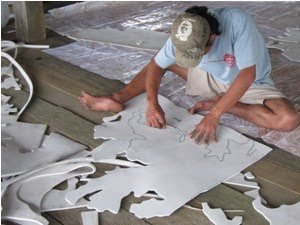 Expanded EVA / PE closed-cell foam or sponge is usually made out of a blend of Ethylene Vinyl Acetate copolymer (also known as EVA) and polyethylene. The product is a lightweight foam material which has a smooth surface and does not absorb water. Generally EVA sheeting is priced competitively, compared with other blown materials and is available in different densities, thicknesses and colours.
Expanded EVA / PE closed-cell foam or sponge is usually made out of a blend of Ethylene Vinyl Acetate copolymer (also known as EVA) and polyethylene. The product is a lightweight foam material which has a smooth surface and does not absorb water. Generally EVA sheeting is priced competitively, compared with other blown materials and is available in different densities, thicknesses and colours.It is one of the materials most popularly known as expanded rubber or foam rubber sheeting.
EVA foam is used to produce - among others - mouse pads, flip flops and sports mats. Sheets of the material can be used for manufacturing Participatory 3D Models.
Models made out of this material are well suited for humid tropical environments where carton board may deteriorate rapidly.
Manufacturing a 3D model using 'expanded EVA / PE closed-cell foam' compared to carton board implies a slightly higher cost and non biodegradable debris, but ensures a more durable output and a consistent vertical scale/exaggeration of the 3D model. Insertion of map and push pins is easy.
More information on the topic is found here.
Friday, January 08, 2010
Interview with Steve deRoy about the role of networking and communication in PGIS practice
In this interview, Mr. Steven DeRoy illustrates the power of networking and the importance of integrating this practice into the daily realm of PGIS. These professional exchanges create an opportunity to dialogue with likeminding professionals, allowing practitioners to share ideas and approaches to solve common challenges. Maps also play a vital role in communicating ideas amongst different parties and for advocating change in current affairs
Google Earth Outreach initiative in Africa
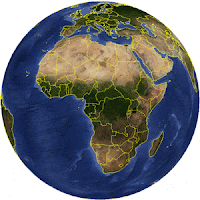 Google Earth Outreach in Africa was recently launched with the objective of enabling non-profit and public benefit organizations in the continent to access the knowledge and resources they need to organize their data, build their maps, tell their stories through geographic visualization.
Google Earth Outreach in Africa was recently launched with the objective of enabling non-profit and public benefit organizations in the continent to access the knowledge and resources they need to organize their data, build their maps, tell their stories through geographic visualization.Monday, December 14, 2009
Community mapping in Borneo
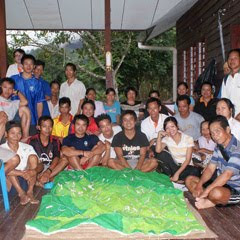 Community members and park naturalists have completed a participatory 3-dimensional scaled model of the Buayan-Kionop area showing areas important for community livelihoods. The pproject, funded by the Darwin Initiative, is designed to contribute to the nomination of the Crocker Range Biosphere Reserve. Work began in August 2009 with local partners and 10 indigenous communities. Local researchers from Buayan-Kionop are sharing their skills with neighbouring communities to document and map community livelihood patterns for the entire Ulu Papar area. They have been using a range of techniques, including participatory GIS and participatory 3-dimensional modelling (P3DM) to show areas important for cultivation, hunting, fishing and gathering of forest products. Over the next 3 years, we will build on the participatory research results in Buayan-Kionop and create spaces for community dialogue on balancing conservation and sustainable resource use in the Crocker Range.
Community members and park naturalists have completed a participatory 3-dimensional scaled model of the Buayan-Kionop area showing areas important for community livelihoods. The pproject, funded by the Darwin Initiative, is designed to contribute to the nomination of the Crocker Range Biosphere Reserve. Work began in August 2009 with local partners and 10 indigenous communities. Local researchers from Buayan-Kionop are sharing their skills with neighbouring communities to document and map community livelihood patterns for the entire Ulu Papar area. They have been using a range of techniques, including participatory GIS and participatory 3-dimensional modelling (P3DM) to show areas important for cultivation, hunting, fishing and gathering of forest products. Over the next 3 years, we will build on the participatory research results in Buayan-Kionop and create spaces for community dialogue on balancing conservation and sustainable resource use in the Crocker Range.More information on the programme is found here.
Source: Agnes Lee Agama, Southeast Asia coordinator, Global Diversity Foundation update December 2009
Friday, November 27, 2009
Eco-cultural mapping to protect natural resources and sacred sites, South Africa
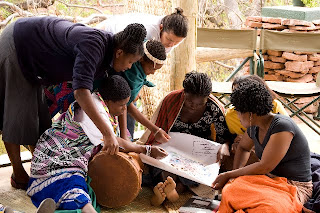 With support from CTA, women, men and youth from Tshidzivhe community, in Limpopo province, northern South Africa, spent six days exploring ways to ‘map’ their traditional knowledge and practices for managing their natural resources. As the different maps were finished, the local people celebrated their new capacity to express traditional environmental knowledge in an appropriate way for gaining recognition, reviving traditional practices and securing their rights.
With support from CTA, women, men and youth from Tshidzivhe community, in Limpopo province, northern South Africa, spent six days exploring ways to ‘map’ their traditional knowledge and practices for managing their natural resources. As the different maps were finished, the local people celebrated their new capacity to express traditional environmental knowledge in an appropriate way for gaining recognition, reviving traditional practices and securing their rights.This was a unique mapping experience that involved local people as well as indigenous from other parts of the world. More than 70 vhaVenda people took part, guided by trainers in eco-cultural mapping from Colombia and accompanied by indigenous leaders from the Colombian Amazon and the Russian Republic of Altai. The process required the full participation of community members, especially the elders and the makhadzis, women custodians of sacred sites, but with minimal materials or technology.
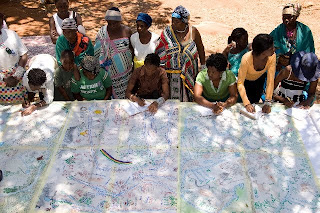 Four maps and two ecological calendars were produced, covering what the local population refers to as “Venda territory” and with special attention to the main sacred sites. The maps show the changes and alterations to the land - the past, present and future visions - and the importance of recovering traditional practices and rituals.
Four maps and two ecological calendars were produced, covering what the local population refers to as “Venda territory” and with special attention to the main sacred sites. The maps show the changes and alterations to the land - the past, present and future visions - and the importance of recovering traditional practices and rituals.Trainees from Kenya and Ethiopia, members of the African Biodiversity Network, took part and hope to carry out similar workshops in their respective countries in 2010.
Photos by Will Baxter, text by Fiona Wilton / The Gaia Foundation
Saturday, November 21, 2009
Ogieks will not be evicted from the Mau forest
As reported by NTVKenya on October 24, 2009 , it is emerging that members of the Ogiek indigenous community will not be affected by the eviction notice. the Mau task force committee says the indigenous forest dwellers will not be moved when the evictions start soon. The announcement came as the Prime Minister gunned for more financial support for the Mau in Europe.
Related news and actions on PPgis.Net Blog:
Ogiek Appeal to the Kenya Government Notice to vacate Mau Forest Complex and other water towers
The 2009 UNESCO World Report on Cultural Diversity makes reference to the Ogiek 3D Mapping
Francis Kakwetin Lesingo reports on the use of a 1:10,000 scale 3D model in Nessuit Kenya
More on indigenous mapping by Ogiek People in the Mau Forest
Friday, November 13, 2009
Peter Poole reports on his experience with community mapping
In this interview, Peter Poole traces the evolution of a map-making methodology which commenced with his introduction of GPS to the Inuit community of Pangnirtung in 1989 and was incubated throughout the 1990’s by a series of ‘tenure mapping’ projects in the Amazon the Arctic and Asia. Tenure maps depict indigenous names, resources and special places on scaled maps, intended as evidence in negotiating land settlements.
Most tenure mapping methods rely upon external cartographic expertise. The “no-name” method enables communities to control the complete information cycle: gathering raw data, their conversion to information, its application.
The interview describes the search for cheap, simple, appropriate geomatic technology.
During several tenure mapping projects in the Amazon, a two-tier arrangement evolved whereby community-based teams would gather raw field data, the most critical task, and indigenous associations or support NGO’s, set up mapping units to serve the field teams.
The interview shifts focus to an overview of global community mapping completed by Peter Poole. In this, he concluded that, in terms of expertise, accessibility and accomplishment, the Philippines. He also drew a broad distinction to tenure mapping in America, a continent whose indigenous peoples sharing a in common ‘500 years since Columbus’ experience, and Africa, where this model does not work and where community mapping is taking off in a refreshing variety of directions.
The interview concludes with three lessons learned:
- Yes, communities can make their own scaled maps.
- The most successful of emerging mapping centres are those whose services are accessible to all communities.
- This capacity-building approach to map making equips and inspires people to diversify their skills in environmental information management. These skills will be wasted unless provisions are made to follow up tenure mapping projects with either further training or employment.
Saturday, November 07, 2009
Friday, November 06, 2009
Dave De Vera elaborates on Participatory GIS practice in the Philippines
Dave De Vera is the Executive Director of the Philippine Association For Intercultural Development (PAFID). In his interview Dave elaborates on the use of Participatory GIS practice in the Philippines to support indigenous communities in filing ancestral land claims. He elaborates on the mapping methods used, explains why P3DM is the most effective, and arguments on the need for local ownership of the process, competency of the technology intermediary, quality work, and constructive relationships with Government. Dave further lists cases of PAFID / Government partnerships and analyses the pillars of process legitimization.
Indigenous Peoples in Africa prepare for Copenhagen - REDD and human rights
Delegates emphasised that indigenous peoples are important stakeholders in climate stabilisation in Africa. Indigenous leaders must educate their communities as to the causes and engage with national governments about equitable and sustainable responses. Delegates reported back on mitigation / REDD (Reducing Emissions from Deforestation and Forest Degradation) workshops that were held this year in Cape Town, Kampala, Nanyuki (Kenya) and Libreville, Gabon. The primary issues were to promote a fair and community-focused approach to REDD plus financing for forest conservation in Africa.
Government forestry officials from Uganda and Kenya gave presentations on how their governments are contracting with local communities to conserve tropical forests, and introduce new forms of carbon financing.
Jeniffer Koinante, Deputy Chairperson of IPACC gave a presentation on how the forest-based indigenous peoples of Kenya are using Participatory 3-Dimensional Models (P3DM) to help them review traditional adaptation customs, knowledge and practices, which could be harnessed to strengthen resilience of ecosystems and communities in the face of climate change.
Saturday, October 24, 2009
The UNESCO World Report on Cultural Diversity makes reference to P3DM done by Ogiek Peoples
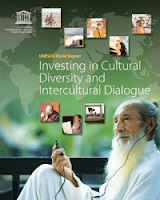 The 420-page UNESCO World Report on Cultural Diversity has been launched by the Director-General, to the attention of the Permanent Delegates to the 35th session of the General Conference, on Tuesday 20 October 2009.
The 420-page UNESCO World Report on Cultural Diversity has been launched by the Director-General, to the attention of the Permanent Delegates to the 35th session of the General Conference, on Tuesday 20 October 2009.The use of participatory three-dimensional modelling (P3DM) by the Ogiek Peoples in Kenya is cited in section 2.4 as an example of local Empowerment (see page 52 of the report).
Specifically the report makes reference to the article published by Rambaldi et al. on Information Development in 2007: Through the eyes of hunters-gatherers: Participatory 3D modelling among the Ogiek indigenous peoples in Kenya.
It is worth noting that the power of participatory mapping coupled with Web 2.0 commnunication tools (ppgis list, blog, YouTube, etc) coupled with actions undertaken by concerned stakeholders, have raised the concerns faced by a minority group like the Ogiek at the forefront of public opinion.
Friday, October 23, 2009
Dr. Robert Chambers elaborates on Participatory GIS (PGIS) practice
Dr. Robert Chambers from the Institute of Development Studies (IDS), UK, reflects on the intersection of participatory development and Geographic Information Systems (GIS) and on the resulting good and bad practices. In the interview Dr. Chambers calls on practitioners and development agencies to ensure that good practice is put in place to avoid the repetition of the misuse of PRA (i.e. Participatory Rural Appraisal) done in the 80's and 90's.
Thursday, October 22, 2009
The future of environmental law mapping
 Laurent Granier from ecocy recently wrote an essay on the future of environmental law mapping where he argues GIS and mapping tools are transforming our vision of legal data, “from vertical books to horizontal maps”. Drawing on examples of online mapping tools and representations, including participatory GIS, he shows a tendency for law and policy makers to aggregate administrative and legal layers in maps, towards more and more legally binding tools.
Laurent Granier from ecocy recently wrote an essay on the future of environmental law mapping where he argues GIS and mapping tools are transforming our vision of legal data, “from vertical books to horizontal maps”. Drawing on examples of online mapping tools and representations, including participatory GIS, he shows a tendency for law and policy makers to aggregate administrative and legal layers in maps, towards more and more legally binding tools.
Sunday, October 18, 2009
Pister la Vie Sauvage dans l'Age de la Cybernétique
Le CTA a fait paraître dernièrement une vidéo éducative sur la technologie CyberTracker. La vidéo est un élément d’un paquet pédagogique, destiné à promouvoir les bonnes pratiques en matière de production, de gestion, d’analyse et de communication de l’information géospatiale. D’une durée de 8 minutes, la vidéo est disponible en anglais, français, espagnol et met l’accent sur de nombreux domaines dans lesquels cette technologie peut être utilisée à des fins de développement et de conservation de l’environnement.
CyberTracker est un logiciel en libre accès (open source) mis au point en Afrique du Sud par l’ONG CyberTracker Conservation avec, à l’origine, le soutien financier de la Commission Européenne. Il peut être installé sur tout appareil portable équipé d’un GPS – un Assistant numérique personnel (PDA) ou un Smartphone, par exemple – et permet de recueillir des données géoréférencées avec des annotations numériques détaillées. C’est un moyen extrêmement efficace de stocker de grandes quantités d’observations géocodées faites sur le terrain, à une vitesse et avec un niveau de précision et de détail inédits. CyberTracker permet aux utilisateurs de personnaliser l’interface pour mieux l’adapter à leurs besoins de collecte de données. Les écrans sont configurés de manière à pouvoir combiner du texte et des icônes, pour garantir ainsi une efficacité et une personnalisation optimales. L’interface icônes de l’application CyberTracker a été initialement conçue pour les pisteurs qui ne pouvaient ni lire ni écrire. Aujourd’hui, tous les utilisateurs – y compris scientifiques et écologistes – mettent à profit cette interface icônes parce qu’elle permet de saisir les données beaucoup plus rapidement.
Saturday, October 17, 2009
Educational Video ob CyberTracker - Tracking in the Cyber Age
The CTA recently released an educational video on CyberTracker technology. The video has been produced in the context of the development of a training kit aimed at supporting the spread of good practice in generating, managing, analysing and communicating spatial information. This 8-min video on CyberTracker covers a number of uses to which geospatial information technology (GIT) can be put to work in the contexts of development and conservation.
CyberTracker is an open-source software developed in South Africa by the Cybertracker Conservation with financial support initially provided of by the European Commission. It can be installed on a GPS-enabled handheld device such as a Personal Digital Assistant (PDA) or a Smartphone to collect geo-referenced data with detailed digital notation. It is a highly efficient way to gather large quantities of geo-coded field observations at a speed and level of detail not possible before. CyberTracker allows users to customise the interface to meet data collection needs. Screen designs can combine text and icons to optimise efficiency and customisation. The CyberTracker icon interface was originally designed for trackers who could not read or write. Nowadays all users including scientists and conservationists benefit from the icon-based interface because it enables significantly faster data entry.
Saturday, October 10, 2009
Participatory 3D Modelling: a Review ...
Participatory 3D Modelling (P3DM) is a community-based mapping method which integrates local spatial knowledge with data on elevation of the land and depth of the sea to produce stand-alone, scaled and geo-referenced relief models. Essentially based on local spatial knowledge, land use and cover, and other features are depicted by informants on the model by the use of pushpins (points), yarns (lines) and paints (polygons). On completion, a scaled and geo-referenced grid is applied to facilitate data extraction or importation. Data depicted on the model are extracted, digitised and plotted. On completion of the exercise the model remains with the community. More information on the method are available at iapad.org
Sunday, October 04, 2009
Une modélisation participative en 3D du paysage montagneux historique de Wechecha (Éthiopie)
Une fois achevée, la maquette a été inaugurée par un représentant du Président de la République fédérale démocratique d'Éthiopie. Cette cérémonie a réuni plus de 500 personnes, parmi lesquelles des membres du Conseil des représentants des peuples, des membres du gouvernement et des représentants d'organisations internationales, d'organisations de la société civile et de collectivités locales.
Construite à l'échelle 1:10 000, la maquette reproduit une zone de 24 km sur 28 km. Plus de 40 élèves et membres d'associations de jeunes ont participé à la construction de la maquette initiale, que les habitants de la région, notamment les anciens, ont été invités à enrichir de leurs connaissances géographiques. Au cours du processus, des informations sur le massif ont été échangées entre les différentes générations, mais aussi avec les collectivités locales et d'autres parties prenantes, ouvrant la porte à des débats de fond sur la gestion et la protection durables de la culture et de l'environnement à l'échelle locale. Les gouverneurs de la région se sont montrés extrêmement favorables à ce projet, jouant un rôle actif au sein du processus, aux côté des organisateurs.
Ce projet avait pour ambition de collecter des données sur le savoir écologique traditionnel des communautés de la région pour le valoriser. Ainsi, les autorités externes lui accorderont davantage d'importance lors de la gestion collaborative des ressources naturelles. L'objectif secondaire du projet consistait à améliorer la transmission de ce savoir aux nouvelles générations.
Maintenant que la maquette est achevée, elle servira d'environnement de référence où habitants, membres du gouvernement et différentes parties prenantes pourront débattre de programmes de gestion et de réhabilitation.
Kalkidan, 15 ans, est une élève de l'école d'Holeta. Elle est consciente que sa génération a appris énormément des anciens de la région grâce à cette maquette. Elle s'est exprimée ainsi lors de l'inauguration : « Nous, les jeunes, ne pensions pas que les anciens en savaient autant. Mais après avoir participé à la construction de cette maquette participative en 3D, nous sommes désormais convaincus que nos anciens sont une mine d'informations sur l'environnement ». Elle a rappelé qu'au cours de ce projet, ce sont les anciens qui ont tenu le premier rôle.
Lors de la cérémonie, des anciens ont montré l'emplacement de leur village d'origine sur la maquette, avec des anecdotes. Ils n'ont pas pu cacher leur désarroi envers la dégradation de la région, et ont demandé aux organismes concernés de tenter de résoudre ce problème. Les membres du gouvernement ont également approuvé la maquette et rappelé qu'elle ne se résumait pas à un simple objet de décoration.
Le Dr Tewoldebithan G/Egziabher, directeur de l'autorité fédérale de protection de l'environnement et président de l'assemblée générale de MELCA, a remis la maquette à la ville d'Holeta et à l'administration du woreda de Walmara au nom de son association. Il a demandé à l'administration d'utiliser la maquette comme référence topographique.
Million Belay, directeur du MELCA, a annoncé de nouvelles initiatives. Un processus de planification à grande échelle sera lancé pour réhabiliter le paysage montagneux de Wechecha, en s'appuyant principalement sur la maquette. Les écoles situées au pied des montagnes intégreront la maquette à leur programme, à l'instar de la région de Nessuit (Kenya), qui possède une maquette comparable depuis 2006. Les enseignants l'utiliseront pour aider les élèves à connaître leur environnement, la géographie et les paysages culturels. Par ailleurs, Million Belay a annoncé que la maquette en 3D servirait à des fins scientifiques, pour étudier d'une part la relation entre habitants et environnement, et d'autre part les conséquences de la dégradation des terres sur les moyens de subsistance des communautés locales.
Auteur : Giacomo Rambaldi
Participatory 3D Model of the historical Wechecha mountain complex, Ethiopia
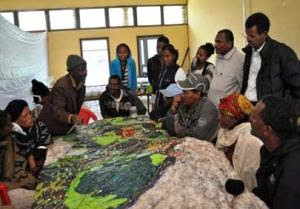 MELCA Mahiber, an Ethiopian NGO which is part of the African Biodiversity Network (ABN) facilitated the construction of a Participatory 3 Dimensional Model (P3DM) of the historical Wechecha mountain complex, which is found in Oromiya Regional State, adjacent to Wolmera and Sebeta Awas Woreda in Ethiopia.
MELCA Mahiber, an Ethiopian NGO which is part of the African Biodiversity Network (ABN) facilitated the construction of a Participatory 3 Dimensional Model (P3DM) of the historical Wechecha mountain complex, which is found in Oromiya Regional State, adjacent to Wolmera and Sebeta Awas Woreda in Ethiopia.Once completed the model has been inaugurated by a Representative of the President of Federal Democratic Republic of Ethiopia. Over 500 people participated in the ceremony including members of the House of People Representative Councils, governmental officials and representatives from international organizations, CSO and local communities.
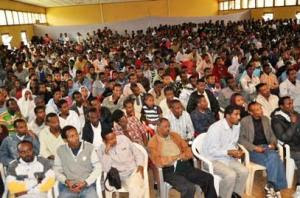 The 1:10.000 scale model covers an area of 24 km by 28 km. Over 40 students and representatives from youth groups constructed the blank model. Residents of the area, especially elders, were invited to populate the map with their spatial knowledge. In the process information about the mountain area has been shared across generations and between local communities and other stakeholders, opening the door for deeper discussions on the sustainable management and safeguarding of both local culture and environment. The local Governors were very supportive. They played an active role in the process together with the organisers.
The 1:10.000 scale model covers an area of 24 km by 28 km. Over 40 students and representatives from youth groups constructed the blank model. Residents of the area, especially elders, were invited to populate the map with their spatial knowledge. In the process information about the mountain area has been shared across generations and between local communities and other stakeholders, opening the door for deeper discussions on the sustainable management and safeguarding of both local culture and environment. The local Governors were very supportive. They played an active role in the process together with the organisers.The objective of the exercise was to document the Traditional Ecological Knowledge (TEK) of resident communities, and add value and authority to it in order to increase the value external authorities would attach to it when it comes to collaborative natural resource management. A second objective of the exercise was to enhance the transfer of TEK the younger generations.
Now thet the model is completed it will as a reference environment where local people, government officials and other stakeholders can discuss management and rehabilitation plans.
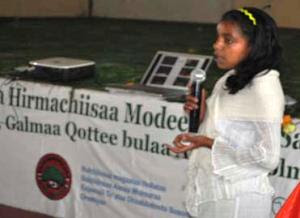 Kalkidan is a 15-year old student at Holeta Primary School. She witnessed how this model created an opportunity for her and her friends to learn a lot from the local elders. At the inauguration she stated the following: “We youngsters didn’t think that elders know, but now, after participating in the construction of this Participatory 3 Dimensional Model, we are convinced that our elders have a deep knowledge about their environment” She recalled that the elders were the main actors on the scene.
Kalkidan is a 15-year old student at Holeta Primary School. She witnessed how this model created an opportunity for her and her friends to learn a lot from the local elders. At the inauguration she stated the following: “We youngsters didn’t think that elders know, but now, after participating in the construction of this Participatory 3 Dimensional Model, we are convinced that our elders have a deep knowledge about their environment” She recalled that the elders were the main actors on the scene. At the ceremony Elders locaed their places of origin on the model and talked about them. They couldn’t hide their feeling that their area is becoming degraded and pleaded for concerned bodies to address this problem. The government representatives also endorsed the model and reiterated that it should not be just for looking at and admiring.”
At the ceremony Elders locaed their places of origin on the model and talked about them. They couldn’t hide their feeling that their area is becoming degraded and pleaded for concerned bodies to address this problem. The government representatives also endorsed the model and reiterated that it should not be just for looking at and admiring.”Dr. Tewoldebithan G/Egziabher, Director of the Federal Environmental Protection Authority and Chairman of MELCA’s General Assembly delivered the model to Holeta Town and Wolmera Woreda Administrations on behalf of MELCA. He told to the Administrations to use the model as a reference for taking measures.
According to Million Belay the Director of MELCA related initiatives will follow: There will be an intensive planning process aiming at rehabilitating the Wechecha Mountain complex and we will ensure that the model will be central to it. Schools located at the foothills of the mountain will make use of the model in their curriculum like it is currently happening in Nessuit Kenya, where a similar model has been constructed in 2006. Teachers use it to facilitate pupils learning about their environment, geography and cultural landscapes. In addition, Mr. Belay stated that the 3D model will be used for scientific research, on the relationship between people and the environment, and to study the impacts of land degradation on the livelihood of local communities.
Thursday, October 01, 2009
Ogiek Appeal to the Kenya Government Notice to vacate Mau Forest Complex and other water towers
Joseph K. Sang, representative from the Ogiek community in Nessuit Kenya, launches an appeal to the Government of Kenya following an eviction notice published on all mayor newspapers on August 25, 2009 and concerning the vacation of the Mau Forest Complex by all illegal occupants.
Francis Kakwetin Lesingo reports on the use of a 1:10,000 scale 3D model in Nessuit Kenya
Mr. Francis Kakwetin Lesingo - a representative from the Ogieks living in the Mau complex (Nakuru,Kenya) - reports back on the use of a 1:10,000 scale georeferenced physical 3d model manufactured by 26 ogiek clans in 2006 and 2007 in Nessuit Kenya. The initiative has benefitted from technical and financial assistance provided by CTA, Ermis Africa, the Indigenous Peoples of Africa Coordinating Committee (IPACC) and the Gaia Foundation UK.
Wednesday, September 30, 2009
The Touch Table for participatory land use planning
This video shows how the Touch Table can be used to support land use planning with multiple stakeholders with multiple interests
Friday, September 18, 2009
Web-Based GIS and the Future of Participatory GIS Applications within Local and Indigenous Communities
Applications of GIS in Community Forestry: Linking Geographic Information Technology to Community Participation
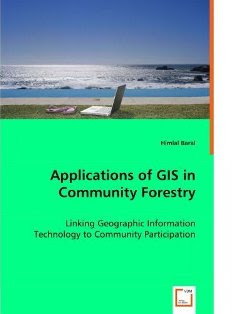
Wednesday, September 16, 2009
How to create a "My Map" in Google Maps
How to create personalized, annotated, customized maps using Google Maps.
Here is an example: P3DM Where?
Head teacher Julius Sangogo reports on the usefullness of a Participatory 3D Model (P3DM) in Nessuit, Kenya
Head teacher Julius Sangogo reports on the usefullness of a Participatory 3D Model in Nessuit, Kenya from CTA on Vimeo.
Three years after the completion of a Participatory 3D model in Nessuit Kenya, head teacher Julius Sangogo recalls the uses of the model by local, national and international agencies and more importantly by the pupils of the local primary school.
The Mystery of Capital among the Indigenous Peoples of the Amazon
Part 1 The Mystery of Capital among the Indigenous Peoples of the Amazon from ILD on Vimeo.
A film directed by James Becket
Conceived of and written by Hernando de Soto
Produced by Bernardo Roca Rey and Hernando de Soto
Research Director Ana Lucía Camaiora
A Becket Films LLC and Institute for Liberty and Democracy Production
Part 2 The Mystery of Capital among the Indigenous Peoples of the Amazon from ILD on Vimeo.
A film directed by James Becket Conceived of and written by Hernando de Soto Produced by Bernardo Roca Rey and Hernando de Soto Research Director Ana Lucía Camaiora A Becket Films LLC and Institute for Liberty and Democracy Production
Part 3 The Mystery of Capital among the Indigenous Peoples of the Amazon from ILD on Vimeo.
A film directed by James Becket Conceived of and written by Hernando de Soto Produced by Bernardo Roca Rey and Hernando de Soto Research Director Ana Lucía Camaiora A Becket Films LLC and Institute for Liberty and Democracy Production
Wednesday, September 09, 2009
Participatory 3D Model (P3DM) of Chivoko village, Solomon Islands
 A total of 60 representatives from the Chivoko community including youth, elders, women and men, students and chiefs; representatives from "Sasamunga Live and Learn", The Nature Conservancy (TNC), the "Lauru Land Conference of Tribal Communities" (LLCTC), and the Choiseul Provincial Fisheries constructed a 1:20,000 scale Participatory 3D Model (P3DM) of Chivoko village in the Tavula ward, Choiseul Province, Solomon Islands. The model covering a total area of 192 sq km is the 1st if its kind in Solomon Islands.
A total of 60 representatives from the Chivoko community including youth, elders, women and men, students and chiefs; representatives from "Sasamunga Live and Learn", The Nature Conservancy (TNC), the "Lauru Land Conference of Tribal Communities" (LLCTC), and the Choiseul Provincial Fisheries constructed a 1:20,000 scale Participatory 3D Model (P3DM) of Chivoko village in the Tavula ward, Choiseul Province, Solomon Islands. The model covering a total area of 192 sq km is the 1st if its kind in Solomon Islands.Tuesday, September 01, 2009
Qualitative GIS: A Mixed Methods Approach
 'Qualitative GIS is coming of age, and this definitive collection explains why it deserves broad attention. These carefully selected essays by leading researchers, organized around a broad conception of qualitative GIS that extends beyond multi-media data integration to embrace new software tools and interpretive, situated epistemologies, will push readers to rethink not only their preconceptions about qualitative GIS, but also about GI science and critical GIS. GIS researchers, practitioners, observers and users will find much to chew on here' - Professor Eric Sheppard, University of Minnesota, USA
'Qualitative GIS is coming of age, and this definitive collection explains why it deserves broad attention. These carefully selected essays by leading researchers, organized around a broad conception of qualitative GIS that extends beyond multi-media data integration to embrace new software tools and interpretive, situated epistemologies, will push readers to rethink not only their preconceptions about qualitative GIS, but also about GI science and critical GIS. GIS researchers, practitioners, observers and users will find much to chew on here' - Professor Eric Sheppard, University of Minnesota, USA Geographic Information Systems are an essential tool for analyzing and representing quantitative spatial data. Qualitative GIS explains the recent integration of qualitative research with Geographical Information Systems
With a detailed contextualising introduction, the text is organised in three sections:
Representation: examines how researchers are using GIS to create new types of representations; working with spatial data, maps, and othervisualizations to incorporate multiple meanings and to provide texture and context. This section includes a chapter by Jon Corbett and Giacomo Rambaldi dealing with participatory mapping by the title: "Geographic information technologies, local knowledge, and change (pages 75-91).
Analysis: discusses the new techniques of analysis that are emerging at the margins between qualitative research and GIS, this in the wider context of a critical review of mixed-methods in geographical research
Theory: questions how knowledge is produced, showing how ideas of 'science' and 'truth' inform research, and demonstrates how qualitative GIS can be used to interrogate discussions of power, community, and social action
Making reference to representation, analysis, and theory throughout, the text shows how to frame questions, collect data, analyze results, and represent findings in a truly integrated way. An important addition to the mixed methods literature, Qualitative GIS will be the standard reference for upper-level students and researchers using qualitative methods and Geographic Information Systems.
Available from Amazon.com (US) and Amazon.co.uk (Europe)
Tuesday, July 21, 2009
Discrete Community Mapping in Sudan
In 2005, the CPA also created the Abyei Arbitration Tribunal (AAT) which issued a Final and Binding Ruling on the north-south border – which could become an international border following a referendum on Southern Sudan independence slated for 2011.
Kharthoum rejected this Ruling, causing a stalemate until May 2008 when the town of Abyei, ancestral centre for the Ngok Dinka, was methodically sacked by a combination of Misseriya militias and troops from Khartoum - displacing 60,000 residents as collateral.
The border delineated by the AAT had been based on exhaustive interviews with elders from the nine Ngok Dinka chiefdoms, coupled with equally exhaustive historical map research. But, none of the sites mentioned by the elders, as evidence of ancestral occupancy, had been geocoded with GPS. The purpose of this mapping project was to rectify that with a repeat performance using GPS.
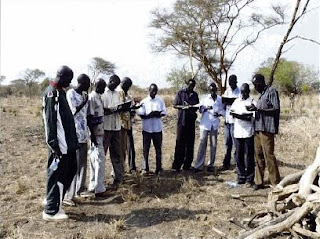 A legal team, from the US-based Public International Law & Policy Group (PILPG) and London-based WilmerHale, along with Southern Sudanese, colleagues re-interviewed the elders during a week long conference of all nine Ngok Dinka chiefdoms to plan the restoration of Abyei. During that same week, a team of 12 Ngok Dinka were trained in the use GPS units, videos and still cameras. At the same time, the lawyers’ interviews provided the information about the significant historical sites needed by the team to build up a legend. For litigational reasons beyond my understanding it was essential to demonstrate that, by 1905, Ngok Dinka had occupied an area well to the north of Abyei town.
A legal team, from the US-based Public International Law & Policy Group (PILPG) and London-based WilmerHale, along with Southern Sudanese, colleagues re-interviewed the elders during a week long conference of all nine Ngok Dinka chiefdoms to plan the restoration of Abyei. During that same week, a team of 12 Ngok Dinka were trained in the use GPS units, videos and still cameras. At the same time, the lawyers’ interviews provided the information about the significant historical sites needed by the team to build up a legend. For litigational reasons beyond my understanding it was essential to demonstrate that, by 1905, Ngok Dinka had occupied an area well to the north of Abyei town.Ngok Dinka memory stretched far further back than 1905. A principle signifier of historical occupancy were sites identified with Names for Age Sets, which were changed every ten years. The elders recited age set names and places going back centuries, the oldest stretched to 1508.
The mapping method was simple. Following the Abyei restoration conference, the team visited each chiefdom in turn and spent a day talking with 25 elders, going over recorded sites and seeking more. They then divided into three units and three vehicles, and selected elders guided them to the sites that had been listed. In two stints over the last winter, the mapping team, covered the disputed area and recorded almost 300 sites. Each evening the mapping log book were written up and emailed to International Mapping, Baltimore, US.
With the critical area covered, it was decided that, for the few days remaining the mapping teams, elders, and lawyers, would travel further north – to sites identified by the elders but outside the area that was critical for the Southern Sudan-Ngok Dinka case.
This brought the project to the attention of officials representing Northern Sudan. They were not too happy about it but all the required data was by then at the cartographers in Baltimore. The last few days were spent either under military escort, or waiting for an escort to materialize, or waiting for it to finish eating somewhere. Three trips were eventually made. To varying degrees they were high on inter-group tension but low on data utility so these data do not appear on the around Abyei. Shortly after, there were rumours of a Kharthoum-driven counter mapping effort, but it was too late.
With only a week of training and field exercises under their belts, the Ngok Dinka mapping team did outstanding work. During the recent Abyei Arbitration Tribunal hearing, lawyers for Kharthoum made a serious effort to dismiss their maps as “tainted data” but in the final exchange, they were outplayed by the legal team for Southern Sudan. For anyone seeking field workers in Southern Sudan, there are now several trained and contactable, but jobless, community information gathering and mapping people in circulation in the Abyei area. The
Verdict will be on this site on Wednesday. http://www.pca-cpa.org/ For a good, detailed account of the Abyei issue visit the Enough Project.
Read also: Dr. Peter Poole 2009. Ngok Dinka Abyei Area Community Mapping Project report, February 2009
Peter Poole, 21 July 2009
Saturday, June 20, 2009
Map symbols and coding means
Appreciating the logic of map symbols begins with understanding the existence of three distinct categories, including point, line and polygons (areas).
Maps and 3D models include generally a combination of all three. These tree main categories can be further differentiated by variations in "hue" (color), "gray tone value", "texture" and "orientation", "shape" and "size".
Each of these variables or their combinations excel in portraying particular features and their variations.
When using color (hue) for characterizing areas, decoding is made simpler when darker means "more" and lighter means "less". Color conventions allow map symbols to exploit idealized associations of water with blue and forested areas with green. This the combination of the two, implies that dense primary forest is dark green, secondary forest green, and grassland light green, and that deep waters are dark blue and shallow waters light blue .
"Size" is more suited to for showing different in amount of count, whereas "variations in gray tone" are preferred for distinguishing differences in rate or intensity. Symbols varying in orientation are useful mostly for representing directional occurrences like winds, migration streams or other. Line symbols best portray water courses, roads, trails, boundaries and may combine different variables, including color and size (thickness). A heavier line readily suggests greater capacity or heavier traffic than a thin line implies.
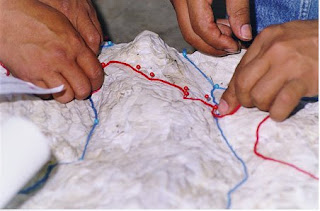
Each symbol should be easily discernable from all others to clearly distinguish unlike features and provide a sense of graphic hierarchy. A poor match between the data and the visual variables may frustrate and confuse the map user.
While in planimetric mapmaking the only limitation in the choice of symbols is fantasy (with logic), participatory 3-D modeling (P3DM) frequently depends on the availability of materials, particularly for point features which are generally represented by push and map pins. Lines and polygons can be easily represented by color-coded yarns and different color paints.
Standardization of symbols serves for ready unambiguous recognition of features and promotes efficiency in both map production and use, exchange of data and comparison. Maps and models sharing a common graphic vocabulary are definitely more powerful in convening the intended message and decoding simpler.
Wednesday, June 17, 2009
P3DM after the 2007 World Summit Award

Since 2005 (year in which the project in Fiji was implemented) Participatory 3D Modelling (P3DM) and been adopted in development contexts in many parts of the world (http://www.p3dm.org/) including Cambodia, Colombia, East Timor, Ethiopia, France, Guyana, Italy, Kenya, Malaysia, Nepal, PNG, Australia and other countries.
The 2007 WSA recognition added value and authority to the method and gave worldwide recognition to its quality and appropriateness.
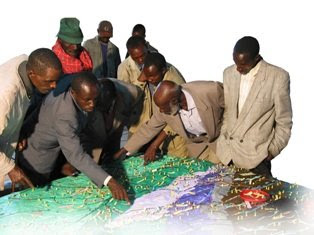 In Kenya P3DM been used by Ogiek, Yiaku and Sengwer Indigenous Peoples to document their biophysical and cultural landscapes. The objectives of these community-led interventions included enhancing inter-generational information exchange, adding value and authority to local knowledge, improving communication with mainstream society, improving planning on sustainable management of natural resources and addressing territorial disputes.
In Kenya P3DM been used by Ogiek, Yiaku and Sengwer Indigenous Peoples to document their biophysical and cultural landscapes. The objectives of these community-led interventions included enhancing inter-generational information exchange, adding value and authority to local knowledge, improving communication with mainstream society, improving planning on sustainable management of natural resources and addressing territorial disputes.  The Indigenous Peoples of Africa Coordinating Committee (IPACC), a pan-African network of 150 organisations adopted the method and is spearheading its adoption in the African Continent to improve awareness at policy-making level on the relevance of location-specific traditional ecological knowledge (TEK) in climate change adaptation and mitigation processes. Read more.
The Indigenous Peoples of Africa Coordinating Committee (IPACC), a pan-African network of 150 organisations adopted the method and is spearheading its adoption in the African Continent to improve awareness at policy-making level on the relevance of location-specific traditional ecological knowledge (TEK) in climate change adaptation and mitigation processes. Read more.UNESCO has been supporting the adoption of P3DM in Niger and Kenya in the context of the of the Convention for the Safeguarding of the Intangible Cultural Heritage paying specific attention on the opportunity for safeguarding traditional ecological knowledge as part of overall intangible cultural heritage and its integration into the education curricula.
In collaboration with national and regional partner organisations, the Technical Centre for Agricultural and Rural Cooperation EU-ACP (CTA) is supporting the dissemination and adoption of P3DM practice in ACP countries. Regional capacity building exercises are scheduled in Central Africa (Gabon and DCR), West Africa (Niger) and Southern Africa (Botswana) in 2010 and 2011.
In collaboration with a number of development agencies, CTA is spearheading the production of a training kit supporting the spread of good practice in generating, managing, analysing and communicating spatial information. The kit includes a module on participatory 3D Modelling.
Other initiatives include the ongoing online participatory translation of a video documentary on P3DM “Giving the Voice to the Unspoken” using the free platform http://dotsub.com/




